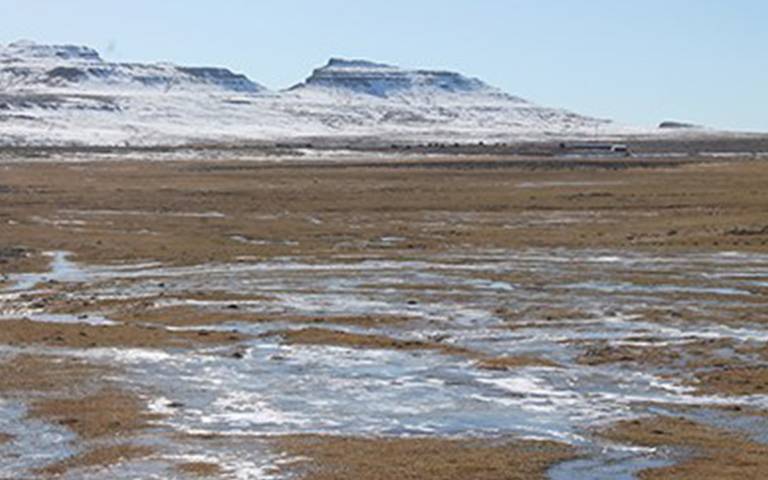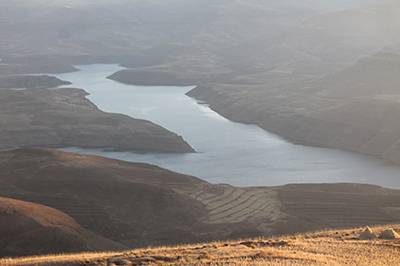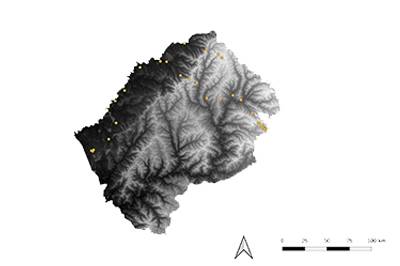Climate and water security in Lesotho
25 August 2022
Professor Jonathan Holmes gives an update on the joint UCL-Wits University project linking water security to regional climate patterns through stable isotope analysis.

As part of the project “Exploring the use of stable isotopes to link water security in Lesotho to regional climate patterns” led by Jen Fitchett (Wits) and Anson Mackay (UCL) and funded jointly by UCL and Wits, project participants took part in fieldwork in Lesotho in June this year.
The fieldwork followed the very successful online webinars on climate, stable isotopes and water resources in Southern Africa, that we held in May 2021.
The highlands of eastern Lesotho are often referred to as the ‘water tower’ of southern Africa because precipitation that falls in this area not only provides water for the subsistence farms of Lesotho itself but also supplies parts of South Africa.
This precipitation is understood to originate from two major sources: the Indian Ocean provides the source for summer rainfall whereas winter precipitation (predominantly snowfall), driven by the westerlies, likely originates from the Atlantic.
Although the current situation in the region is one of water surplus, Lesotho is especially vulnerable to climate change. The country itself has limited available capital for climate change adaptation.
Moreover, changes in the total amount and seasonal distribution of precipitation in the future pose a significant risk to the water security and economic stability of adjacent South Africa.
The project aims to investigate how regional climate patterns will affect Lesotho, and assess the likely implications of such changes for Lesotho itself and the adjacent parts of South Africa.
The project is harnessing complementary expertise in UCL and Wits and builds on existing collaborations that we have built up between the two institutions.
A key component of the project is to use oxygen- and hydrogen isotopes of waters as tracers for hydrological processes in Lesotho, in particular, to trace the sources of rainfall that feed surface waters in different parts of the country.
There appears to be a total lack of such data for Lesotho, despite its importance in regional hydrology and in the project we set out to remedy this, at least in a preliminary way, and to pave the way for future data collection.
Fieldwork
Jen Fitchett and Simoné Dahms-Verster (both from Wits) along with Chris Curtis (University of Johannesburg) and Jonathan Holmes (UCL) set out in June to collect surface water (mainly rivers and streams) and precipitation from a range of sites in Lesotho.
These span a range of altitudes and locations, to evaluate spatial and altitudinal gradients in water-isotope composition, and to determine whether the isotope composition of surface waters in Lesotho can be used as a tracer for moisture source.
We sampled over thirty sites (snow, streams, rivers and lakes) for oxygen and hydrogen isotopes and basic water chemistry from across much of Lesotho, from the eastern highlands, at nearly 3000 metres above sea level, down to the lowlands in the western part of the country close to the border with South Africa.


Initial results and next steps
The water samples we collected have been run in the Geography-Earth Sciences stable-isotope facility (BEIF – the Bloomsbury Environmental Isotope Facility). Interpretations are currently underway.
We also aim to collect rainfall over the coming 12 months at three strategically-located sites, Pretoria, Bloemfontein and Durban, to capture precipitation from different sources (Atlantic and the Indian Ocean).
Although all three sites are in South Africa for logistical purposes, they will still provide us with much-needed information about precipitation sources. We built rain collectors from materials procured locally In Johannesburg and designed them to prevent evaporation of collected rain.
The collectors have been deployed now in their respective localities and academic volunteers will be responsible for emptying them weekly and returning the samples for isotope analysis. We aim to continue measurements for at least one year.
The results will provide much-needed information about precipitation regimes across Southern Africa.
 Close
Close

